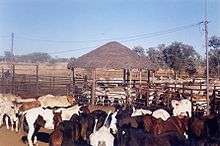Station (Australian agriculture)

In Australia, a station is a large landholding used for livestock production. It corresponds to American ranches that operate under the Taylor Grazing Act of 1934 on public lands. The owner of a station is called a pastoralist or a grazier (which correspond to the North American term rancher).
Originally station referred to the owner's house and the outbuildings of a pastoral property, but it now generally refers to the whole holding. Stations in Australia are on Crown land pastoral leases, and are known colloquially as sheep stations or cattle stations as most are stock specific, dependent upon the country and rainfall. The operators or owners are thus known as pastoralists.[1][2]
Sizes
Sheep and cattle stations can be thousands of square kilometres in area, with the nearest neighbour being hundreds of kilometres away. Anna Creek Station in South Australia is the world's largest working cattle station.[3] It is roughly 24,000 square kilometres (5,900,000 acres) which is 8,000 km2 larger than Alexandria Station, a cattle station spanning more than 1.8 million hectares in the Northern Territory and four times the size of America's biggest ranch, which is only 6,000 km2.[4][5]
Facilities
Because of the extended distances, there is a School of the Air so that children can attend classes from their homes, originally using pedal powered radios to communicate with the teachers. The larger stations have their own school and teacher to educate the children on the station until at least they commence high school. Large isolated stations have their own stores to supply workers with their needs.
Medical assistance is given by the Royal Flying Doctor Service, where medical staff such as doctors and nurses can treat patients at their homes, or airlift emergency and seriously ill patients to hospitals at the nearest towns. The Westpac Life Saver Rescue Helicopter Service and its trained medical crews also respond quickly to emergencies threatening the life, health and safety of people caused through medical emergency, illness, natural disaster, accidents or mishap.
Personnel
A station hand is an employee, who is involved in routine duties on a station and this may also involve caring for livestock.
Some stations are in remote areas that are not easy to access, limiting their population greatly. Accommodation for couples and families may be limited.[6] Consequently, many station employees are young and temporary. An important example is the jackaroo (male) or jillaroo (female), a young person who works on a station for several years in a form of apprenticeship, in order to become an overseer or rural property manager.[7][8] Aborigines have played a big part in the northern cattle industry where they were competent stockmen on the cattle stations. Nowadays staff on these stations may work in the homestead and in stock camps. Stockmen, especially ringers, may be seasonal employees. Others include boremen, managers, mechanics, machinery operators (including grader drivers), station and camp cooks, teachers, overseers and bookkeepers. Veterinary surgeons also fly to some of the more distant cattle and sheep stations.
Popular culture
The long-running television drama McLeod's Daughters is set on an Australian cattle station.
The film Australia was set on a fictional station Faraway Downs, but parts were filmed on Home Valley Station.[9]
Jeannie Gunn arrived at Elsey Station in 1902, leaving after her husband died, and in 1908 wrote the book We of the Never Never based on her time at on the property.[10]
Elsey also featured in the 1946 film The Overlanders, the crew set up camp on the property for a month. The river crossing sequence was shot at the Roper River.[11]
See also
- Pastoral lease
- List of ranches and stations § Australia
- List of the largest stations in Australia
- Outstation
- Station (New Zealand agriculture)
References
- ↑ Taylor, Peter (1988), Station life in Australia : pioneers and pastoralists, Allen & Unwin, ISBN 978-0-04-332135-5
- ↑ "Chisholm, Alec H.". The Australian Encyclopaedia. 8. Sydney: Halstead Press. 1963. p. 275.
- ↑ Mercer, Phil (2008-06-09). "Cattle farms lure Australian women". BBC. Retrieved 2008-06-09.
- ↑ Crozier, Randall (2005-07-14). "Big, big Anna Creek Station". SA Country Hour Summary. Australian Broadcasting Corporation. Retrieved 2008-11-17.
- ↑ "Anna Creek Station". Wrightsair. Retrieved 2008-02-08.
- ↑ NAPCO
- ↑ Delbridge, Arthur, The Macquarie Dictionary, 2nd ed., p. 937, Macquarie Library, North Ryde, 1991
- ↑ Chisholm, Alec H. (ed.), The Australian Encyclopaedia, "Jackeroo", Halstead Press, Sydney, 1963
- ↑ "Faraway Downs Station Kununurra Australia". Retrieved 25 April 2015.
- ↑ Rutledge, Martha (2000). "Gunn, Jeannie (1870–1961)". Melbourne University Press. Retrieved 10 May 2014.
- ↑ ""Overlanders" film unit returns". The Sydney Morning Herald. New South Wsles: National Library of Australia. 5 September 1945. p. 5. Retrieved 10 May 2014.
External links
 Media related to Sheep and cattle stations in Australia at Wikimedia Commons
Media related to Sheep and cattle stations in Australia at Wikimedia Commons